Pune: The Cultural Capital of Maharashtra
Pune, the cultural and historical capital of Maharashtra, is also known as the “Queen of the Deccan” due to its scenic beauty, rich natural resources, and vibrant legacy. It is the birthplace of the revered saint Sant Tukaram, and the capital of Chhatrapati Shivaji Maharaj, the legendary warrior king who laid the foundation of Hindavi Swarajya. The city continues to attract talent from across the country, resulting in rapid population growth and increased urban migration in recent decades.
However, this surge has placed significant pressure on Pune’s infrastructure, particularly its public transportation system. With the average daily commute on public transport exceeding 100 minutes, many residents increasingly rely on private vehicles. This has led to severe traffic congestion, longer travel times, and increased environmental pollution in Pune.
To address these challenges, the Pune Metro has been envisioned as a transformative step toward creating a sustainable urban mobility solution. Designed to reduce travel time by up to 75%, the Metro will provide a comfortable, efficient, and eco-friendly mode of transport for Pune residents.
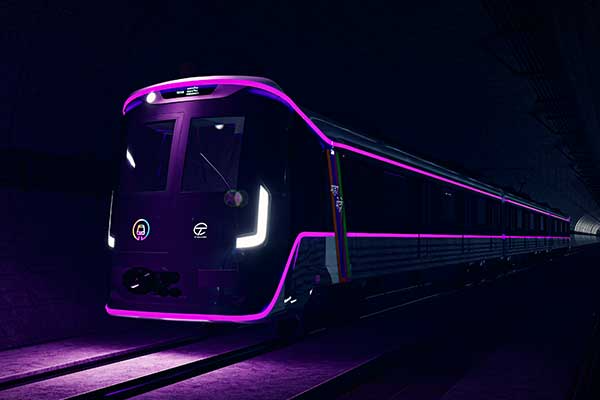
Pune Metro: Driving the City Toward Smarter Mobility
Overview
- Pune Metro is an under-construction urban Mass Rapid Transit System (MRTS) comprising 3 lines in the city of Pune, Maharashtra.
- The Pune Metro project has been undertaken by MAHA Metro, a SPV (Special Purpose Vehicle) of the Government of India and the Government of Maharashtra and the Pune Metropolitan Region Development Authority (PMRDA).
- Currently, Phase 1 of Pune Metro, which comprises 2 lines, is operational.

Key Specification
| Speed and Track | Top Speed: 80 kmph |
| Average Speed: 34 kmph | |
| Standard Gauge: 1435 mm | |
| Electrification | 25 kV, 50 Hz AC OHE |
| Signalling | Communication-based Train Control (CBTC) |
| Fare Collection | Automatic fare collection system with a combination of smart cards & computerised paper tickets |
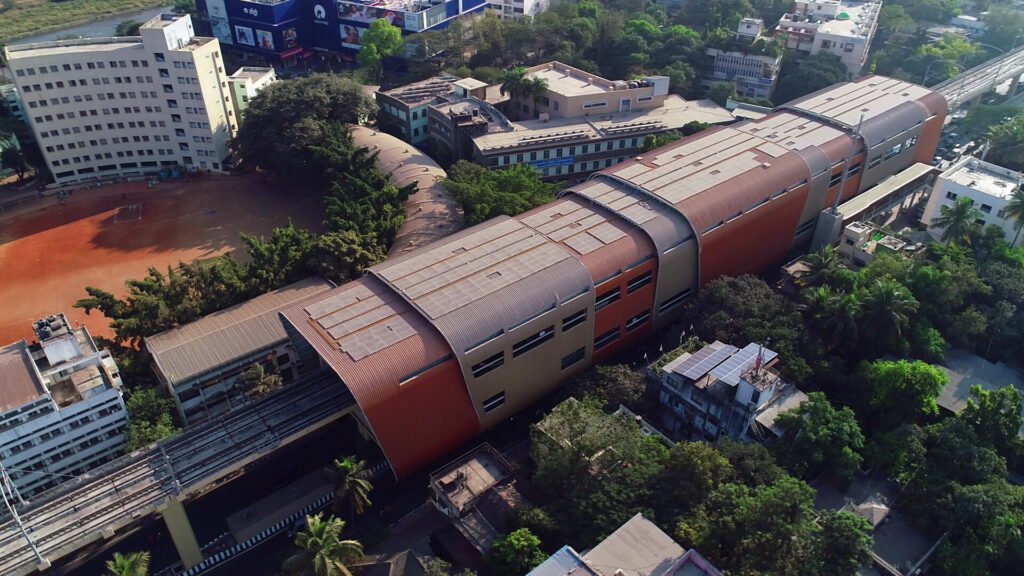
Phase 1 of Pune Metro
Overview
- Phase 1 of the Pune Metro project consists of two operational corridors spanning a total length of 31.254 km.
- In July 2009 when the Delhi Metro Rail Corporation (DMRC) prepared and submitted the initial Detailed Project Report (DPR).
- Over the following years, the DPR underwent multiple revisions, first in January 2013, again in August 2014, and a third time in November 2015 to reflect the project cost.
- The project received formal approval from the Government of Maharashtra in 2012, and in December 2016, it gained final clearance from the Union Cabinet of India.
- The foundation stone for Pune Metro Phase 1 was laid by Hon’ble Prime Minister Shri Narendra Modi on 24th December 2016. The project work commenced on 3rd May 2017.

Funding Mechanism
Pune Metro Phase 1, with a total project cost of ₹11,420 crore, is funded through a balanced mix of government equity and international loans.
- GoI & GoM- Equity and Subordinate debt (50:50) – ₹ 1,954.00 Crore each
- Grant from GoM Entities – ₹ 28.50 Crore
- GoM Grant for land and taxes – ₹ 302.20 Crore
- Loan from EIB, Luxembourg – ₹ 4,140.71 Crore (Euro 600 million)
- Loan from AFD, France – ₹ 1,690.79 Crore (Euro 245 million)
- SD for Land including R&R and State Taxes from ULB – ₹ 1,210.80 Crore
- IDC to be borne by GOM & ULBs – ₹ 139.00 Crore
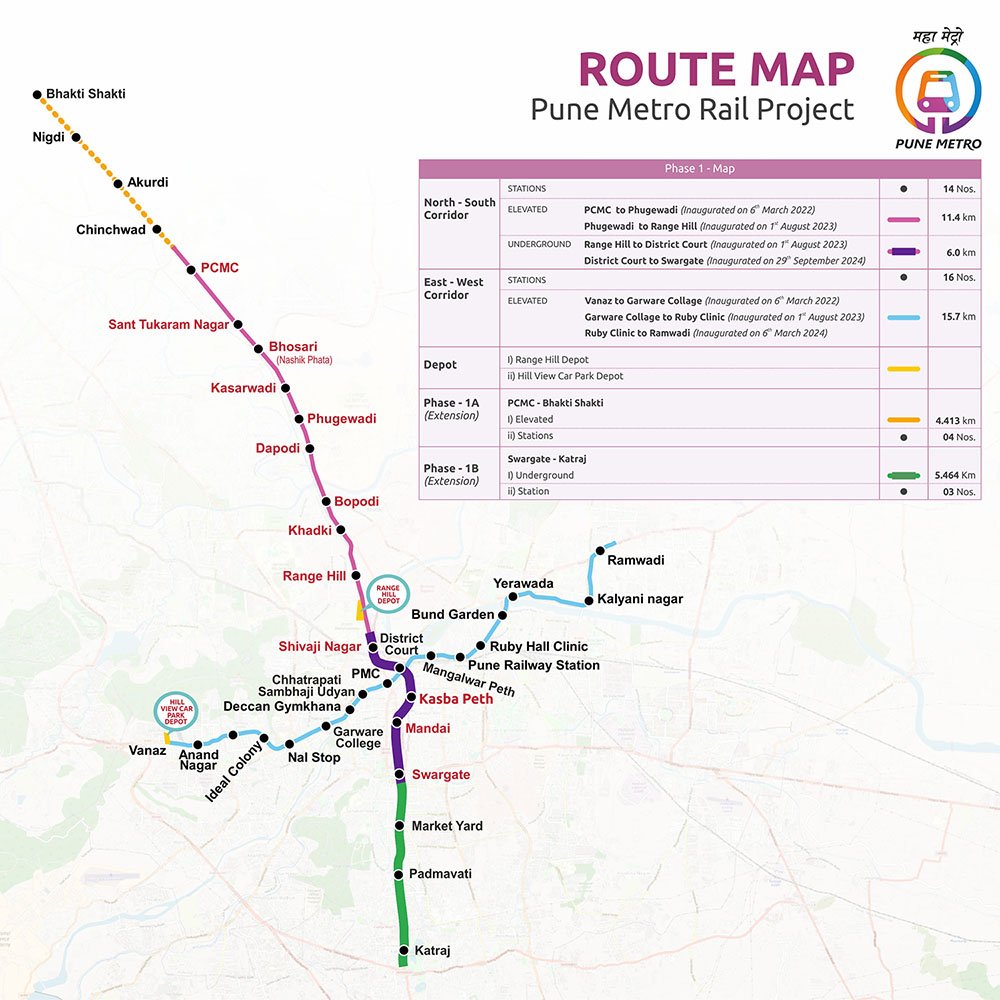
Route Detail of Phase 1
Line-1 (Purple Line): Pimpri Chinchwad Municipal Corporation (PCMC) – Swargate
- Length: 16.589 km
- Number of Stations: 14
- Station Names: PCMC, Tukaram Nagar, Bhosari, Kasarwadi, Fugewadi, Dapodi, Bopodi, Khadki, Range Hill, Shivaji Nagar, Civil Court, Budhwar Peth, Mandai, Swargate
Line-2 (Aqua Line): Vanaz – Ramwadi
- Length: 14.665 km
- Number of Stations: 16
- Station Names: Vanaz, Anand Nagar, Ideal Colony, Nal Stop, Garware College, Deccan Gymkhana, Sambhaji Park, PMC, Civil Court, Mangalwar Peth, Pune Railway Station, Ruby Clinic, Bund Garden, Yerawada, Kalyani Nagar, Ramwadi.
Timeline of Phase 1
| Line | Route | Length | Operational Date |
| Purple Line | PCMC – Phugewadi | 6 km | 6 March 2022 |
| Aqua Line | Vanaz – Garware College | 4.35 km | 6 March 2022 |
| Purple Line | Phugewadi – Civil Court | 8.03 km | 1 August 2023 |
| Aqua Line | Garware College – Ruby Clinic Hall | 5.45 km | 1 August 2023 |
| Aqua Line | Ruby Clinic Hall – Ramwadi | 5.94 km | 6 March 2024 |
| Purple Line | District Court – Swargate | 3.30 km | 29 September 2024 |
Phase 1 Extension
Overview
Phase 1A of the Pune Metro involves the extension of Pune Metro Phase 1’s Purple Line in both directions. SYSTRA MVA Consulting prepared the Detailed Project Report ( DPR) of the Pune Metro Phase 1 Extension.
| Pune Metro’s Purple Line | ||||
| Line | Route | Length | Stations | Status |
| Orignal Line | PCMC – Swargate | 16.59 km | 12 Stations | Operational |
| Northern Extension | PCMC to Bhakti Shakti | 4.519 km | 4 Stations | Under Construction |
| Southern Extension | Swargate – Katraj | (5.464 km | 3 Stations | Under Implementation |
Purple Line’s Northern Extension
- The Purple Line’s under-construction northern extension spans 4.519 km from PCMC to Nigdi through 4 stations.
- The central government cabinet approved this extension in October 2023 with an estimated cost of Rs. 910.18 crore.
Purple Line’s Southern Extension
- The Purple Line’s under implementation southern extension spans 5.46 km from Swargate to Katraj, covering 3 underground stations.
- The central government cabinet approved this extension in August 2024 with an estimated cost of Rs. 2954.53 crore.
Route Detail of Phase 1 Extension
Purple Line: Pimpri Chinchwad Municipal Corporation (PCMC) – Bhakti Shakti
- Length: 4.519 km
- Type: Elevated
- Number of Stations: 4
- Station Names: Chinchwad, Akurdi, Nigdi and Bhakti Shakti
Purple Line: Swargate – Katraj
- Length: 5.464 km
- Type: Underground
- Number of Stations: 3
- Station Names: Market Yard (Gultekdi), Saibaba Nagar and Katraj
| Latest Update: Purple Line’s Northern Extension In June 2025, YFC Projects – BBG Infrastructure JV received a Letter of Acceptance (LoA) from Maha-Metro for the civil contract of Pune Metro Purple Line’s northern extension, which includes the construction of all 4 stations located on this section. Stations: Chinchwad, Akurdi, Nigdi and Bhakti Shakti Purple Line’s Southern Extension In April 2025, Maha-Metro invited bids for the first civil contract of Pune Metro’s Southern Extension. The contract includes the Design and Construction of Underground Stations at Market Yard, Padmavati, Katraj Stations & Associated Tunnels in Stage I And Stations at Bibwewadi & Balaji Nagar in Stage II. |
Phase 2 of the Pune Metro Project
Overview
Originally, Maha Metro proposed an 82.5 km network within Phase 2 of Pune Metro. It includes the extension of the existing Aqua Line in both directions, along with 2 new metro corridors. So far, 44.09km routes have been approved for construction.
Approved Routes in Phase 2
- Aqua Line Extension: The Central government approved the extension of Line 2 in June 2025. The extensions will cost Rs 3626.24 crore, which will be equally shared by the Government of India, the Government of Maharashtra, and external bilateral/multilateral agencies.
Corridor 2A: Vanaz – Chandni Chowk
- Length: 1.12 km
- Type: Elevated
- Number of Stations: 2
- Station Names: Kothrud Bus Depot & Chandni Chowk
Corridor 2B: Ramwadi – Wagholi
- Length: 11.63 km
- Type: Elevated
- Number of Stations: 11
- Station Names: Viman Nagar, Somnath Nagar, Kharadi Bypass, Tulaja Bhavani, Ubale Nagar, Upper Kharadi Road, Wagheswar Temple, Wagholi, Siddharth Nagar, Bakori Phata and Vitthalwadi
Ridership Trends on the Entire Aqua Line After Commissioning of The Project
| Year | Projected Ridership |
| 2027 | 0.96 lakh |
| 2037 | 2.01 lakh |
| 2047 | 2.87 lakh |
| 2057 | 3.49 lakh |
- Khadakwasla – Swargate – Hadapsar – Kharadi Route: This corridor will come up as Line 5 within Pune Metro Phase 2 project. Maharashtra government approved this route in October 2024 at an estimated to cost ₹8,131 crore.
- Length: 25.518 km
- Type: Elevated
- Number of Stations: 22
- Station Names: Khadakwasla, Dalvewadi, Nanded City, Dhayari Phata, Manik Baug, Hingane Chowk, Rajaram Bridge, Deshpande Udyan, Dandekar Pul, Swargate North, Seven Loves Chowk, PCB, Race Couse, Fatima Nagar, Ramtekdi, Hadapsar, Magarpatta South, Magarpatta Main, Magarpatta North, Hadapsar Railway Station, Sainath Nagar and Kharadi Chowk
- SNDT – Warje – Manik Baug: This section will act as spur line of Khadakwasla – Swargate – Hadapsar – Kharadi corridor. This section will span 6 km from Nal Stop to Manik Baug via Warje. This section will be constructed at an estimated cost of Rs 1,765 crore.
| Update: Line 5 of the Pune Metro, along with its proposed spur, is still awaiting final clearance from the central government. In the meantime, Maha Metro has initiated preliminary works, including the design development for 14 out of the 22 planned elevated stations along the Kharadi–Khadakwasla corridor. |
Proposed Route
High Capacity Mass Transit Route (HCMTR or Ring Line): Ambedkar Chowk – Siddhi Garden – Lulla Nagar – Viman Nagar- Deccan College – Kirloskar
- Length: 36 km
- Type: Elevated
- Number of Stations: 44
- Station Names: Ambedkar Chowk, University Back Gate, University Main Gate, JW Marriott, Patrakar Nagar, Kelewadi, Paud Phata, Alankar Police Chowk, Saket Society, Siddhi Garden, Senadatta Police Chowk, NS Phadke Chowk, Sanas Ground, Laxmi Narayan Chowk, City Pride, Market Station, Market Yard Bus Depot, Gangadham Chowk, Bibewadi, Lulla Nagar, Samvidhan Chowk, Jambhulkar Chowk, Fatima Nagar, Kalubai, Ghorpodi, Pingle Vasti, Tadigutta Junction, East Avenue Road, Vadgaon Sheri, Viman Nagar, Clover Park, Sakore Nagar, Pune Airport, 509 Junction, Shahu Maharaj Chowk, Vishrantwadi, Sathe Biscuit, Vishrantwadi Police Station, Home Guard, Deccan College, Holkar Jal Shuddi, Kirkee Methodist Church, Kirkee and Kirloskar
Line 3 of Pune Metro
Overview
Pune Metro Line-3, also known as the Puneri Metro, is a 23.3 km elevated metro corridor designed to connect Hinjewadi with Shivajinagar’s Civil Court through 23 elevated stations.
On October 3, 2018, the Pune Metropolitan Region Development Authority (PMRDA) awarded the project to a consortium comprising:
- TRIL Urban Transport Private Limited (a Tata Group company)
- Siemens Project Ventures GmbH
The consortium subsequently formed a Special Purpose Vehicle (SPV) named Pune IT City Metro Rail Limited on March 14, 2019, which is responsible for the project’s execution.
A 35-year concession agreement was signed between PMRDA and Pune IT City Metro Rail Limited in September 2019, outlining the terms for development, operation, and transfer of the metro line.
The project is being developed under the Public-Private Partnership (PPP) model on a Design, Build, Finance, Operate, and Transfer (DBFOT) basis, with an estimated budget of ₹8,100 crore.
- The Government of Maharashtra approved the project on February 9, 2018.
- The Government of India granted in-principle approval for providing 20% Viability Gap Funding (VGF) on March 7, 2018.
- The State Government’s VGF contribution was approved on August 27, 2019, primarily through land transfers from various state agencies (e.g., Dairy Development, Pune Police).
Route Details
Line-3: Hinjawadi – Civil Court
- Length: 23.33 km
- Type: Elevated
- Depot: Maan Village (20 hectares)
- Number of Stations: 23
- Station Names: Megapolis Circle, Embassy Quadron Business Park, Dohler, Infosys Phase II, Wipro Phase II, Pall India, Shivaji Chowk, Hinjewadi, Wakad Chowk, Balewadi Stadium, NICMAR, Ram Nagar, Laxmi Nagar, Balewadi Phata, Baner Gaon, Baner, Krushi Anusadhan, Sakal Nagar, University, R.B.I., Agriculture College, Shivaji Nagar and Civil Court.
Line 4 (Civil Court – Loni Kalbhor)
Pune Metropolitan Region Development Authority (PMRDA) proposed a 18 km metro corridor that will extend from Civil Court and conclude at Loni Kalbhor. The detailed project report of this line was prepared by Delhi Metro Rail Corporation. This Line is likely to serve as the extension of existing Pune Metro Line 3. This line is planned to be executed on PPP model.
PMC Approves 2 New Metro Routes for the Expansion of Pune Metro
In February 2025, the Pune Municipal Corporation (PMC) approved two proposed metro corridors Hadapsar to Loni Kalbhor and Hadapsar to Saswad Road. The implementation of both lines is expected to be undertaken by the Pune Metropolitan Region Development Authority (PMRDA) at Rs 5,704 crore. As per the approved terms, PMC will not provide any financial guarantee for loan repayments. Instead, its role is limited to a specific allocation of ₹3.6 crore towards land acquisition required for the project, as stated by Municipal Commissioner Rajendra Bhosale..
Approved Routes’ Details
Hadapsar – Loni Kalbhor
- Length: 11.352 km
- Type: Elevated
- Number of Stations: 10
- Estimated Cost: Rs. 3445.42 crore
Hadapsar Bus Depot – Sasvad Road
- Length: 5.573 km
- Type: Elevated
- Number of Stations: 4
- Estimated Cost: Rs. 1340.85 crore
Progress on Pune Metro Rail Project
1. Addition of Rolling Stock
Pune Metro is set to expand its fleet with 15 new trains (45 coaches). This move will increase the total number of operational trains from 34 to 49 and the number of coaches from 102 to 147. Each train will consist of three coaches.
These additional trains are being procured to support the recently approved extension of the Vanaz-Ramwadi corridor (Aqua Line) in both the eastern and western directions under Phase 2.
Impact of Pune Metro Expansion
Traffic Patterns and Ridership Trends:
As Pune is becoming hub for educational and economic actives the traffic congestion has emerged a major challenge for the city. The Pune Metro was envisioned as a high-capacity public transport system to reduce dependency on private vehicles and improve urban mobility. As per the Detailed Project Report (DPR) prepared in 2015, the system was projected to handle approximately 600,000 daily riders upon full operation of Phase 1. However, as of May 2025, the average daily ridership stood at approximately 1.53 lakh passengers, representing around 25% of the projected figure. According to the World Population Review, the Pune Metropolitan Region including Pimpri-Chinchwad is estimated to have a population of 7.5 million in 2025. Concurrently, vehicle registration data from the city’s two Regional Transport Offices (RTOs) indicate that the number of registered vehicles has surpassed 6.5 million. These figures highlight the current underutilisation of the metro system relative to its designed capacity and underline the need for continued efforts in network expansion. However, the metro connectivity to key IT Hubs is expected to increase the ridership in future with commencement of new corridors including Line 3 and Line 5 of Pune Metro.
Impact of Pune Metro on Urban Real Estate Market: Opportunity for Investors
The ongoing expansion of the Pune Metro network is expected to improve accessibility across several key residential and commercial zones, particularly in areas such as Kharadi, Hinjewadi, Baner, Katraj, Chandni Chowk, and Wagholi. These regions, which host prominent IT parks and residential clusters, stand to benefit from the metro connectivity which will influence the real estate market along the routes.
Residential properties located within close proximity (typically within 500–800 metres) of metro stations are experiencing increased interest from both end-users and investors. According to market data, areas such as Hinjewadi have shown an annual appreciation of approximately 7% in residential property values, a trend expected to strengthen with the operationalisation of the Pune Metro Line 3. Similarly, the state approval of Khadakwasla–Kharadi metro corridor has increased the pricing in the Kharadi region. .
Baner and Balewadi have also observed a 15–20% increase in property prices since the metro project’s announcement, attributable to improved connectivity. Available data indicates that improved metro connectivity has a measurable impact on real estate markets and it will create opportunities for investors through increased property demand and value appreciation in well-connected urban zones.
Reduction in Carbon Emission
Maharashtra Metro Rail Corporation Ltd. (Maha Metro) has undertaken a structured approach to incorporate green infrastructure into the Pune Metro system with aim to decrease the carbon footprint. As part of its Green Metro initiative, Maha Metro aims to install solar photovoltaic (PV) systems across all elevated operational metro stations and depots to partially meet energy requirements through renewable sources.
A key installation includes a 750 kW rooftop solar plant on the Integrated Workshop Building at the Range Hill Depot, which is capable of generating approximately 2,800 kWh of electricity per day. Furthermore, on 25 January 2024, Maha Metro commissioned a larger 4,300 kWp solar power plant at the same depot. Across Lines 1 and 2, a network of solar power systems installed at 10 stations and two depots collectively generates around 15,557 kWh of electricity per day.
As per the latest available data, this solar integration currently accounts for approximately 40% of Pune Metro’s total electricity consumption. According to Maha Metro estimates, the solar initiative could lead to an annual cost saving of approximately ₹6.53 crore in electricity expenses. As the ridership will increase with decrease of private vehicles, the Pune Metro will lead the city towards a sustainable future.
Conclusion
The Pune Metro project signifies a strategic shift in the city’s approach to urban mobility, responding to rising population, congestion, and environmental concerns with a technically strong and sustainable mass transit solution. The project will help the city evolve in multiple aspects. Upon the completion of all the under-construction corridors, the city will have strong connectivity, which will propel it toward achieving its SDGs and economic goals. However, there is a pressing need to address the ridership issues, which rely on multiple factors, to fully leverage the potential of the project with attractive policies curated around a commuter-centric approach.
Pune Metro is laying the foundation for a well-connected metropolitan region. As the system expands to 100+ km in the coming years, it will play a vital role in shifting modal preferences, improving air quality, optimising urban land use, and promoting inclusive access to economic and social opportunities across Pune.



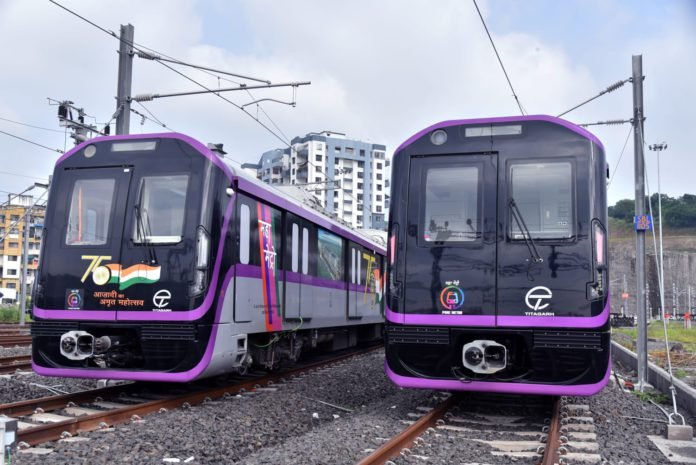
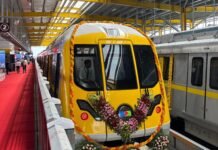


Great job bro.
The details mentioned in this page is amazing and usefull too
Thank you for being so informative.
Keep up the good work